德国双元制职业教育培训总结
- 格式:docx
- 大小:19.23 KB
- 文档页数:6
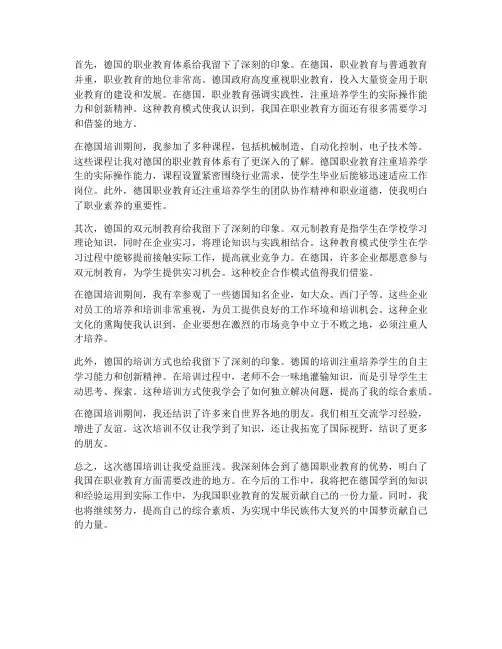
首先,德国的职业教育体系给我留下了深刻的印象。
在德国,职业教育与普通教育并重,职业教育的地位非常高。
德国政府高度重视职业教育,投入大量资金用于职业教育的建设和发展。
在德国,职业教育强调实践性,注重培养学生的实际操作能力和创新精神。
这种教育模式使我认识到,我国在职业教育方面还有很多需要学习和借鉴的地方。
在德国培训期间,我参加了多种课程,包括机械制造、自动化控制、电子技术等。
这些课程让我对德国的职业教育体系有了更深入的了解。
德国职业教育注重培养学生的实际操作能力,课程设置紧密围绕行业需求,使学生毕业后能够迅速适应工作岗位。
此外,德国职业教育还注重培养学生的团队协作精神和职业道德,使我明白了职业素养的重要性。
其次,德国的双元制教育给我留下了深刻的印象。
双元制教育是指学生在学校学习理论知识,同时在企业实习,将理论知识与实践相结合。
这种教育模式使学生在学习过程中能够提前接触实际工作,提高就业竞争力。
在德国,许多企业都愿意参与双元制教育,为学生提供实习机会。
这种校企合作模式值得我们借鉴。
在德国培训期间,我有幸参观了一些德国知名企业,如大众、西门子等。
这些企业对员工的培养和培训非常重视,为员工提供良好的工作环境和培训机会。
这种企业文化的熏陶使我认识到,企业要想在激烈的市场竞争中立于不败之地,必须注重人才培养。
此外,德国的培训方式也给我留下了深刻的印象。
德国的培训注重培养学生的自主学习能力和创新精神。
在培训过程中,老师不会一味地灌输知识,而是引导学生主动思考、探索。
这种培训方式使我学会了如何独立解决问题,提高了我的综合素质。
在德国培训期间,我还结识了许多来自世界各地的朋友。
我们相互交流学习经验,增进了友谊。
这次培训不仅让我学到了知识,还让我拓宽了国际视野,结识了更多的朋友。
总之,这次德国培训让我受益匪浅。
我深刻体会到了德国职业教育的优势,明白了我国在职业教育方面需要改进的地方。
在今后的工作中,我将把在德国学到的知识和经验运用到实际工作中,为我国职业教育的发展贡献自己的一份力量。

427S. Billett et al. (eds.), International Handbook of Research in Professionaland Practice-based Learning , Springer International Handbooks of Education,DOI 10.1007/978-94-017-8902-8_16, © Springer Science+Business Media Dordrecht 2014A bstract T he dual system of vocational education and training (VET) in Germany is a specifi c training system that aims at systematically combining the advantages of training in a company and education in a vocational school. Germany’s dual system is expected to strongly support a successful transition of young people from school to work and to guarantee a skilled workforce as a prerequisite for a successful economy. In addition it plays a role in educating young people. The central goal of VET in the dual system is to help students attain and develop competence in action so that they can meet current and future professional challenges and participate in defi ning their voca-tional lives. Because of on-going changes in society, economy and at the workplaces, the dual system has been under pressure of adaptation in order to further maintain its effectiveness and effi cacy. Consequently, especially since the 1980s, many adjustment processes have taken place on different levels of the system, namely the institutions involved, the syllabi for the different venues, and the teaching-learning processes. The article will explain the dual system as well as highlight and comment on the different endeavours for its modernisation. It focuses on parity of esteem between general and vocational education and between different forms of vocational education. Furthermore it takes into account cost and benefi t of in-company training, modularisation of training occupations, and the relationship between learning and working. As a result, it will give some advice on what can be learnt about education for professions.K eywords V ocational education and training • D ual system • E ducation for professionsC hapter 16The Dual System of Vocational Education and Training in Germany– What Can Be Learnt About Education for (Other) ProfessionsB ärbel F ürstenau ,M atthias P ilz ,and P hilipp G onon B . F ürstenau (*)F aculty of Business and Economics ,T U Dresden ,D resden ,G ermanye -mail: baerbel.fuerstenau@tu-dresden.deM . P ilzF aculty of Economics ,U niversity of Cologne ,K öln ,G ermanyP . G ononI nstitute of Educational Sciences ,U niversity of Zurich ,Z ürich ,S witzerland428B. Fürstenau et al.16.1 O utlineD ual systems of vocational education and training (VET) are specifi c training systems that aim at systematically combining the advantages of training in a company and education in a vocational school. Dual systems in this form do exist to a con-siderable extent in Germany, Austria, Luxemburg, Switzerland, Denmark, and parts of the Netherlands. German-speaking regions of France and Italy also (often) fi t into this framework. This article focuses on the dual system of VET in Germany (hereafter only referred to as “dual system”).G ermany’s dual system is expected to strongly support a successful transition of young people from school to work and to guarantee a skilled workforce as a prerequisite for a successful economy. In addition it plays a role in educating young people. Consequently, the central goal of VET in the dual system is to help students attain and develop competence in action so that they can meet current and future professional challenges and participate in defi ning their vocational lives.I n order to meet this challenge and in order to further maintain its effectiveness and effi cacy, especially since the 1980s, many adjustment measures have been imple-mented. Reasons for the adjustment measures can be seen – besides others – in the demographic development, shift from industrial to service economy, or changes of workplaces and demands for the workforce. The demographic development has led to a drop in the demand for training places and thus to problems of recruiting a skilled workforce. The shift from industrial to service economy has required an increase in apprenticeships in the service sector and more service orientation of apprenticeships in other sectors of the economy. Workplaces have become more complex and require more intellectual skills such as systems thinking, and they require continuous learning. The measures taken refer to different levels of the dual system, namely the institutions involved (companies in the private sector, vocational schools, employers and employees, the F ederal Government, the German states etc.), the syllabi for the learning venues (schools and workplaces), and the working and/or learning processes at the different venues. The levels cannot be strictly separated. Accordingly, if a decision is taken on one level, the other levels are usually affected too.T his article will explain the dual system as well as highlight and comment on the different endeavours for its modernisation. As a result, we will point out what can be learnt about education for professions. The concept of profession here is understood in a broad sense, including professional practice and approaches to learning in and for professions as well as all kinds of initial and further professional education, whether it takes place in school settings or at the workplace or at both venues. Thus, we pick out aspects from education in the dual system which might be regarded in professional education in general. We explicitly do not aim at discussing a transfer of the dual s ystem to other s ystems of professional education in detail but only comment briefl y on it. Through our approach, we aim at contributing to solutions for the problem of effectively developing professional (occupational) capacities that are important for fulfi lling both personal and societal needs.429 16 The Dual System of Vocational Education and Training in Germany…T he article starts with a description of the historical development of the dual system and its current structure in Germany. After that, an overview of current challenges and reform approaches will be taken into account. Consequently, we select relevant topics to be looked at in more detail. The selected topics address the different levels of the dual system and are – in our opinion – relevant both from a national and an international perspective. On the level of institutions, we discuss the parity of esteem between general and vocational education on the one hand and between apprenticeship in the dual system and full-time school-based vocational education on the other hand. Furthermore, on that level, costs and benefi ts of vocational education will be discussed. On the level of syllabi we examine/consider initiatives that have been taken to more closely relate teaching/educational goals and contents to practice and workplace reality as well as to regional or branch-specifi c needs. For that purpose, new apprenticeships have been developed and existing ones have been re-structured according to modules. On the level of teaching-learning processes we focus on measures aiming at preparing apprentices to effectively cope with modern work structures and organisations that have been implemented. For that purpose, the relationship between learning and working is reconsidered and combinations of learning and working, both at the workplace and in school, will be addressed. Though it would be possible and worthwhile to argue solely from a national perspec-tive, we also will discuss the topics from an international perspective, which allows us to consider the German approaches from other angles and integrate it in a broader context. As a summary, we will conclude what can be learned about education for other professions by taking into account the different levels and by regarding an international perspective.16.2 H istorical Development of the Dual Systemof Vocational Education and TrainingT he roots of the dual system can be traced back to the medieval ages, or even beyond, to the ancient Roman and Greek world (e.g. Münk 2010, p. 401). Based on early forms of apprenticeship, the dual system unfolds in three major phases:E arly forms of apprenticeship had been embedded in the craft system for both craftsmen and merchants. The apprentice worked together with his (or her) master craftsmen in his/her shop or travelled together with the master merchant to trade merchandise. Apprenticeship usually followed the so-called Imitatio Majorum prin-ciple, which refers to the sequence of observation, imitation, autonomous accom-plishment, and customisation (Kell 1995, p. 371). It aimed at providing the apprentice with abilities and skills matching the conventions and the accepted behaviour in the profession and the respective craft system (Bruchhäuser and Horlebein 2010, p. 408). Due to technological and cultural developments in industry and society, general knowledge, e.g. qualifi cations of reading, writing and accounting, became more and more important, and thus schooling became necessary in order to prepare apprentices for job requirements (Pahl 2012, pp. 25ff; Reinisch and Götzl 2013, p. 20).430B. Fürstenau et al.T he founding phase of the dual system in Germany can be dated back to the late nineteenth and early twentieth centuries (Greinert 1995). The craft system decom-posed because of the advent of a more liberal trade law, as fixed in the Trade Regulations of the Northern German Confederation. However, the empire politics aimed at protecting craft by law in order to prevent middle-class, respectively small fi rms and traders from becoming proletariat (Greinert 1995, p. 21). Amendments for protecting retail trade, dated 1897, enabled the recovery of corporate structures and the apprenticeship model comparable to that of the former craft system.F urthermore, education of apprentices required a master’s certifi cate. Besides traditional apprenticeships, schools for further education with a specifi c focus on vocational subjects (in German: Fortbildungsschule) were established. In 1900 the German Pedagogue Georg Kerschensteiner had recommended gearing the Fortbildungsschule towards vocational education and, in so doing, to legitimise it by claiming that vocational education and professional work contributes to general human education. Through vocational education, non-academic youth should also be integrated into the national state (Gonon 2009). Between the end of the nineteenth century and the beginning of the twentieth century, the number of such vocationally oriented schools increased. To sum up, the formation of the Fortbil-dungsschule is result of the promotion of small- and medium-sized craft enterprises on the one hand and youth education in times of crisis at the turn of the twentieth century on the other (Harney 2006, p. 233).T he c onsolidation phase between 1920 and 1970 was infl uenced by the attempt of German industry to establish an own apprenticeship model under exclusive control of companies. This was motivated by qualifi cation needs of industry (engine building and electrical industry) that grew comparatively fast and used modern production methods. Consequently, workforce in industry had to learn to cope with new technology. For that, instruction at specifi c learning venues (e.g. apprenticeship workshops or factory schools), standardised courses, curricula, and test requirements were necessary (Herkner 2013, p. 16; Pahl 2012). However, industry could not implement its own apprenticeship model but instead implemented a new qualifi ca-tion type for skilled workers/technicians that compares with the level of assistant in craft (Benner 1997, p. 56). Since the 1930s, the Fortbildungsschule has been renamed V ocational School (in German: Berufsschule). In 1938, (empire-wide) 3 years of compulsory VET was enacted and, in the beginning of the 1940s, the weekly hours of schooling were fi xed while curricula and both school authorities and fi nancing were harmonised. In the 1950s, the craft was successful in enforcing comprehensive regulations for VET established by the Handicrafts Regulations Act (in German: Handwerksordnung). However, a VET law was not enacted until 1969, the so-called Berufsbildungsgesetz (Wahle 2007, p. 195).T he f urther development phase since the 1970s is characterised by rationalisation of the dual system and by enhanced state infl uence. The Berufsbildungsgesetz regulates the responsibilities of Federal Government, the German States, the repre-sentatives of employers, the trade unions and, to some extent, the teachers for voca-tional education. Furthermore, a reporting system aimed at making the developments on the apprenticeship market transparent was established in form of the vocational431 16 The Dual System of Vocational Education and Training in Germany…education report, which is published yearly. In addition, since 1972 inter- c ompany vocational training centers were established to compensate apprenticeship shortcomings, especially for small fi rms. Almost every apprenticeship now also had a structure that separates 1 year of basic vocational qualifi cation from 2 years of specifi c vocational education (Greinert 1995, p. 32).16.3 T he Dual System of V ocational Educationand Training – Basic FeaturesW orldwide, different systems of VET exist. In order to differentiate between these systems, the role of the state can be taken into account. In market economy systems (e.g. USA, Japan, Great Britain) the state is not involved in vocational education. In school systems (e.g. France) the state plans, organises, and controls vocational education. In state-controlled market economy systems (e.g. the dual systems in Germany, Austria, and Switzerland), the state defines regulations for vocational education, but the private sector is responsible for the supply of training places. All other systems can be interpreted as variation of these three basic types.S tudents can enter the dual system after fi nishing 10 years of compulsory schooling on the secondary level I at a grammar school, a comprehensive school, an intermediate school, or a secondary general school. Entering the dual system means entering the secondary II level. As an alternative to the dual system, students can choose to complement senior classes in grammar school, to attend a specialised grammar school, to attend a full-time vocational school, or to remain in the transi-tion system to receive preparation for an apprenticeship in the dual system. After fi nishing one of these alternative tracks, it is also possible to apply for an appren-ticeship training place. Currently, about two-thirds of students leaving school start their professional career by beginning an apprenticeship in the dual system (BMBF 2013, p. 9). Overall, the dual system can be regarded as bridge from school to work-life.A pprenticeship in the dual system is only possible for state-recognised training occupations (Greinert 1995, p. 35), of which currently approximately 350 exist, ranging from baker, boat-builder, hairdresser, optician, and precision mechanic to sales associate or clerk. Successful completion of an apprenticeship programme entitles the trainee to practise an occupation as a qualifi ed skilled worker in either the training occupation ( H ippach-Schneider et al. 2007, p. 25) or an occupation which requires the knowledge and skills of the training occupation. Training occu-pations and occupations/professions in the labour market in general do not neces-sarily correspond. In contrast, compared to the number of training occupations, multiple occupations/professions exist. Occupations can be grouped according to areas, main groups, groups, sub-groups, and genres. Currently, 10 areas, 37 main groups, 144 groups, 700 sub-groups, and 1,286 genres exist. Areas are, for example, agriculture, forestry, and gardening or raw materials production, production and manufacturing, or commercial service, trade, sales, hotel and tourism. Main groups432B. Fürstenau et al.in the latter area are purchasing, sales, and trade occupations or sales, tourism, hotel- and restaurant occupations. Groups in the purchasing, sales, and trade occu-pations are purchasing and sales or trade. Sub-groups within purchasing and sales are occupations in purchasing or clerks in trade. Genres within purchasing and sales are occupations are, for example, specialised trade clerks and unspecialised trade clerks (Bundesagentur für Arbeit 2012). Consequently, an apprentice who completed a training occupation as a clerk can apply for numerous occupations and work as a clerk or as specialised or unspecialised trade clerk, or even as a secretary.T he dual system is not the only possibility for complementing an apprenticeship. Full-time vocational education in schools is offered as well, but it is not as established and appreciated as vocational education in the dual system. Furthermore, the dual system has to be strongly distinguished from the general education system. It has its own vocational education legislation as fi xed in the Berufsbildungsgesetz (Greinert 1995, p. 10).T he name dual system refers to the fact that two learning venues in two institutions, namely vocational schools and workplaces in companies, cooperate in order to qualify apprentices for a profession (Greinert 1995, pp. 10–16). Depending on the state-recognised training occupation, the course of the apprenticeship takes 2–3.5 years. The apprentices spend approximately three fourths of this time in the companies, one fourth in vocational schools. The different learning venues are embedded in different systems formed by a different history, i. e. the vocational training system on the one hand and the school system on the other. Both systems aim at cooperating in qualifying the apprentices (Harney 2006, p. 232). From a legal point of view, the young people are both student and employee. The most important features of the dual system can be described as follows.16.3.1 C ompa nies/Workpla cesT raining places are offered by companies in the private sector (industry, craft, and agriculture), institutions of the public sector, offi ces or institutes of the liberal professions and, to a limited amount, by private households (Greinert 1995, p. 35; Hippach-Schneider and Hensen 2012, p. 16). A provider of training places, e.g. a company, has to be approved by the respective chamber or guild. In the dual system, “the state delegates regulatory competence for training system to corporatist bodies. […] They have the status of ‘competent bodies’ ( z uständige Stellen)and play a crucial role in the organisation, administration and examination of vocational training” (Ertl and Sloane 2004, p. 3). Chambers and guilds as corporatist bodies regulate apprenticeships by supervising final exams, by registering training contracts, by establishing inter-company vocational training centers, by allocating training warranties to companies, by reforming apprenticeships, and by controlling the training quality (Harney 2006, p. 232; Rebmann et al. 2011, p. 13). The in-company training follows mandatory training regulations legal for the respective state- r ecognised training occupation and valid for all companies independent of433 16 The Dual System of Vocational Education and Training in Germany…branch or size. The development and remittal of the training regulations is the responsibility of the federal government and should guarantee comparable standards for in- c ompany training nationwide. However, representatives of trade unions as well as of employers’ and employees’ head organisations are involved in the development of training regulations. Every training regulation comprises denomi-nation, length (duration) of the apprenticeship, occupational profi le, framework plan, and examination requirements (Rebmann et al. 2011, p. 13).T rainers only complete a basic course on pedagogical eligibility (AEVO 2009), or sometimes even none. Usually trainers work as full-time employees and not as full-time trainers. Thus, they often suffer from heavy work pressure and, conse-quently, time limits for taking care of trainees. Big companies usually are more likely to offer systematic training compared to small and medium size companies.T he companies fi nance the apprenticeships by paying training remunerations to the trainee on a monthly basis (Greinert 1995, p. 16). The individual company decides autonomously whether and what training is provided and how many apprentices they take (Hippach-Schneider et al. 2007, p. 59).I t should be mentioned that sometimes companies are not able to offer full apprenticeships. They either do not have enough trainers or suffi cient technical resources. In that case, parts of the apprenticeship can be relocated from the individual company to an inter-company vocational training center. Alternatively several com-panies can form an apprenticeship network, thereby jointly taking care of an apprentice (Hippach-Schneider and Hensen 2012, p. 17).16.3.2 V oca tiona l Schools/Cla ssesV ocational schools have the task of complementing in-company training by imparting both general knowledge and job-specifi c knowledge to the students. The students (=apprentices) attend the vocational school 8–16 h a week. Education in schools complies with a framework curriculum that is developed for every state- r ecognised training occupation (Hippach-Schneider and Hensen 2012, p. 16) by the Standing Conference of the Ministers of Education and Cultural Affairs of the Länder in the Federal Republic of Germany (in German: Kultusministerkonferenz), or rather its subcommittee, and is valid nationwide. As is true for the in-company training regu-lations, the framework curriculum aims at guaranteeing a uniform national standard for education in vocational schools. Because education in schools is the responsibil-ity of the individual states (and not of the federal government), each of the German states can modify the framework curriculum according to specifi c needs but must adhere to central aims and contents. F urthermore, each state issues school laws which regulate kinds of schools (e.g. vocational schools, commercial high schools), educational plans, and lesson plans. In addition, each state issues regulations concerning tests, giving marks, promotion to the next class, and exams (Rebmann et al. 2011, pp. 9–10).434B. Fürstenau et al.T eachers for vocational schools take 5 years of university education and graduate with a master’s degree or a state examination. After that they have to complete a 1–2 year (depending on the regulation of the respective German State) internship in a vocational school. Only after completing these requirements are they fully certifi ed to teach.T he respective German state, or specifi cally the local authorities’ public funds, covers the costs for in-school education (Greinert 1995, p. 16). The German states “bear the costs of internal school affairs (e.g. supervision of schools, laying down of curricula, teacher training, teachers’ pay), and the local authorities are responsible for fi nancing external school affairs (e.g. construction, maintenance and renovation of school buildings, ongoing management, procurement of teaching and learning resources)” (Hippach-Schneider et al. 2007, p. 59).16.3.3 C oordina tion of Schools a nd Compa niesT he coordination of in-company training and school-based learning is strictly regulated by a procedure to develop and harmonise training regulations and school curricula in order to jointly accomplish a central aim. As defi ned in every framework curriculum, the central aim of education in vocational schools is to support students in developing competence in action, which means possessing the willingness and ability to act deliberately and be socially and individually responsible in the workplace as well as societal and private situations. Competence in action develops in three dimensions, namely in professional competence, individual competence, and social competence (KMK 2011, p. 15; Dilger and Sloane 2012, p. 32). The same aim is true for in-company training. The coordination on the local level between individual schools and companies is not regulated and often either happens by chance or is instigated for specifi c reasons, e.g. misbehavior of the apprentice in matters such as daily attendance.16.4 C urrent Challenges and Reform Approaches of theDual System of Vocational Education and TrainingT he most important asset of the dual system is seen in the fact that it comes with a low rate of youth unemployment compared to other European countries. In Germany, the rate was about 9 % in 2011 (Esser 2011, p. 3; Hippach-Schneider and Hensen 2012, p. 10) and has remained low even during the latest economic crisis. Countries that implemented school-based vocational training or have no VET system are typically confronted with high rates of youth unemployment (Busemeyer 2012, pp. 6, 9). The dual system effectively enables the transition from apprenticeship to employment because vocational and occupational systems are closely linked (Bosch 2010, p. 37).435 16 The Dual System of Vocational Education and Training in Germany…By offering apprenticeships, companies can easily support young workers in their commitment to professional development and thus recruit from a skilled workforce (Busemeyer 2012, p. 16).I n order to guarantee a skilled workforce, the dual system is under constant pressure to change or adapt in response to economic, societal, and educational developments. Those developments comprise, for example demographic change, the shift to the service sector, the development of a European work and education market, or new forms of work organisation (BMBF 2012). They lead to challenges in multiple areas: the availability and suitability of training places, the integration of low-skilled youth in VET, the establishing of a European framework for education and training, the training of a highly-qualifi ed future workforce.16.4.1 A vailability and Suitability of Training PlacesT aking the big picture of the apprenticeship market into account, the demand for apprenticeship training places exceeded the supply until 2007. In 2008 the global fi nancial crisis negatively infl uenced economic growth and led to a drop in training places. Since 2011, the amount of training places has again increased (Bosch 2010, p. 37; Deutscher Bundestag 2010, p. 1; Hippach-Schneider and Hensen 2012, pp. 9, 18). Due to demographic change, companies lack skilled personnel. The age group of young people between 17 and 25 is expected to diminish about one-fi fth (BMBF 2012, p. 5). Consequently, companies face the increasing problem of recruiting suitable apprentices (BMBF2012, pp. 4, 7, 24; Autorengruppe Bildungsberi-chterstattung 2012, pp. 101, 107). The percentage of vacant apprenticeship training positions increased about 30 % (Esser 2011, p. 3). More than one-third of compa-nies could not fill one or more apprenticeship training positions. Dependent on branch, size of the company, and the region, the imbalance of supply and demand on the apprenticeship market varies. Concerning the branch, problems mainly occur in the largest sector of the economy, the service sector (BMBF 2012, p. 5; Hippach-Schneider and Hensen 2012, p. 29), e.g. the hotel and catering industry, or the health care and welfare sector. In addition, a qualifi ed workforce is missing in science and technical fi elds. In contrast, banks and insurance companies are less likely to run into problems. Concerning the size, small enterprises have more problems fi lling positions than large fi rms. And concerning the region, big cities in the western part of Germany with a balanced labour market and high dynamics are more likely to have a balanced apprenticeship market than big cities, also in the western part of Germany, which already have a high rate of unemployment and regions in the eastern part of the country (Krone 2010, p. 27f.; BMBF 2012, p. 33). Resulting from demographic changes, companies cannot afford to be as selective as before when hiring apprentices. Thus, the group of apprentices for one state-recognised training occupation in one company, and also across companies, sometimes may be very heterogeneous. That, in turn, may cause problems for both the trainers and the apprentices.。
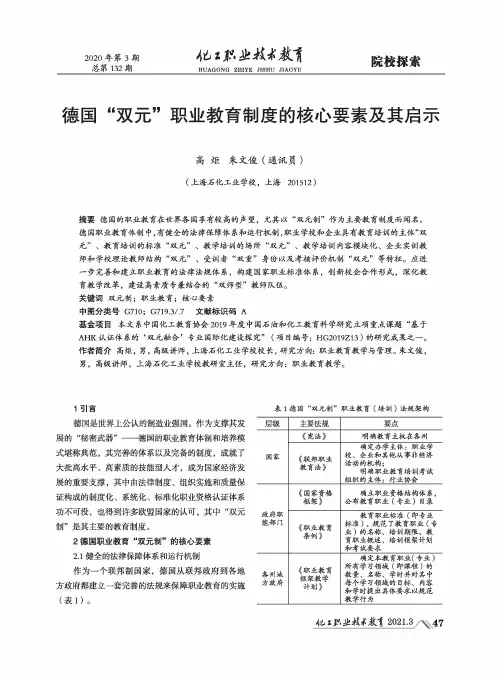
20严年第3期化Z黑虫玻术挝总第132期HUAGONG ZHIYE JISHU JIAOYU院校探索德国“双元”职业教育制度的核心要素及其启示高炬朱文俊(通讯员)(上海石化工业学校,上海201512)摘要德国的职业教育在世界各国享有较高的声望,尤其以“双元制”作为主要教育制度而闻名。
德国职业教育体制中,有健全的法律保障体系和运行机制,职业学校和企业具有教育培训的主体“双元”、教育培训的标准“双元”、教学培训的场所“双元”、教学培训内容模块化、企业实训教师和学校理论教师结构“双元”、受训者“双重”身份以及考核评价机制“双元”等特征。
应进一步完善和建立职业教育的法律法规体系,构建国家职业标准体系,创新校企合作形式,深化教育教学改革,建设高素质专兼结合的“双师型”教师队伍。
关键词双元制;职业教育;核心要素中图分类号G710;G719.3/.7文献标识码A基金项目本文系中国化工教育协会2019年度中国石油和化工教育科学研究立项重点课题“基于AHK认证体系的'双元融合'专业国际化建设探究”(项目编号:HG2019Z13)的研究成果之一。
作者简介高炬,男,高级讲师,上海石化工业学校校长,研究方向:职业教育教学与管理。
朱文俊,男,高级讲师,上海石化工业学校教研室主任,研究方向:职业教育教学。
1引言德国是世界上公认的制造业强国。
作为支撑其发展的“秘密武器”国的职业教育体制和培养模式堪称典范,其完善的体系以及完备的制度,成就了大批高水平、高素质的技能型人才,成为国家经济发展的重要支撑,其中由法律制度、组织实施和质量保证构成的制度化、系统化、标准化职业资格认证体系功不可没,也得到许多欧盟国家的认可,其中“双元制”是其主要的教育制度。
2德国职业教育“双元制”的核心要素2.1健全的法律保障体系和运行机制作为一个联邦制国家,德国从联邦政府到各地方政府都建立一套完善的法规来保障职业教育的实施(表1)。
表1德国"双元制”职业教育(培训)法规架构层级主要法规要点国家《宪法》明确教育主权在各州《联邦职业教育法》确定办学主体:职业学校、企业和其他从事非经济活为的机构;明确职业教育培训考试组织的主体:行业协会政府职能部门《国家资格框架》确空职业资格结构体系,公布教育职业(专业)目录《职业教育条例》教育职业标准(即专业标准),规范了教育职业(专业)的名称、培训期限、教育职业概述、培训框架计划和考试要求各州地方政府《职业教育框架教学计划>确定本教育职业(专业)所有学习领域(即课程)的数量、名称、学时并对其中每个学习领域的目标、内容和学时提出具体要求以规范教学行为化z那垒玻*怒2021.3、47同时,德国建立并形成了由联邦政府(教育部门、经济部门和劳动部门,以及联邦职业教育研究所)主导,各州政府和行业协会实施管理,以企业和职业学校为”双元”教育主体,行业协会负责职业资格认证考核的运行体制。
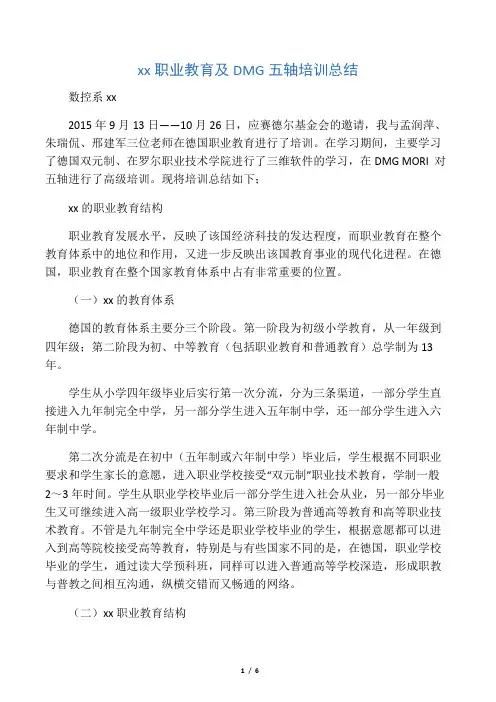
xx职业教育及DMG五轴培训总结数控系xx2015年9月13日——10月26日,应赛德尔基金会的邀请,我与孟润萍、朱瑞侃、邢建军三位老师在德国职业教育进行了培训。
在学习期间,主要学习了德国双元制、在罗尔职业技术学院进行了三维软件的学习,在DMG MORI 对五轴进行了高级培训。
现将培训总结如下;xx的职业教育结构职业教育发展水平,反映了该国经济科技的发达程度,而职业教育在整个教育体系中的地位和作用,又进一步反映出该国教育事业的现代化进程。
在德国,职业教育在整个国家教育体系中占有非常重要的位置。
(一)xx的教育体系德国的教育体系主要分三个阶段。
第一阶段为初级小学教育,从一年级到四年级;第二阶段为初、中等教育(包括职业教育和普通教育)总学制为13年。
学生从小学四年级毕业后实行第一次分流,分为三条渠道,一部分学生直接进入九年制完全中学,另一部分学生进入五年制中学,还一部分学生进入六年制中学。
第二次分流是在初中(五年制或六年制中学)毕业后,学生根据不同职业要求和学生家长的意愿,进入职业学校接受“双元制”职业技术教育,学制一般2~3年时间。
学生从职业学校毕业后一部分学生进入社会从业,另一部分毕业生又可继续进入高一级职业学校学习。
第三阶段为普通高等教育和高等职业技术教育。
不管是九年制完全中学还是职业学校毕业的学生,根据意愿都可以进入到高等院校接受高等教育,特别是与有些国家不同的是,在德国,职业学校毕业的学生,通过读大学预科班,同样可以进入普通高等学校深造,形成职教与普教之间相互沟通,纵横交错而又畅通的网络。
(二)xx职业教育结构德国实施的职业教育一般分为两种类型:即初级职业教育和继续职业培训。
初级职业教育基本属于职前教育,教育对象以尚未就业的青年人为主;继续职业培训属一种在职教育,教育对象以从业人员或失业者为主。
(1)xx职业教育的基本思想“双元制”是德国被实践证明行之有效的职业教育制度。
它确保了各个行业及各个地区职业培训较高的质量标准。
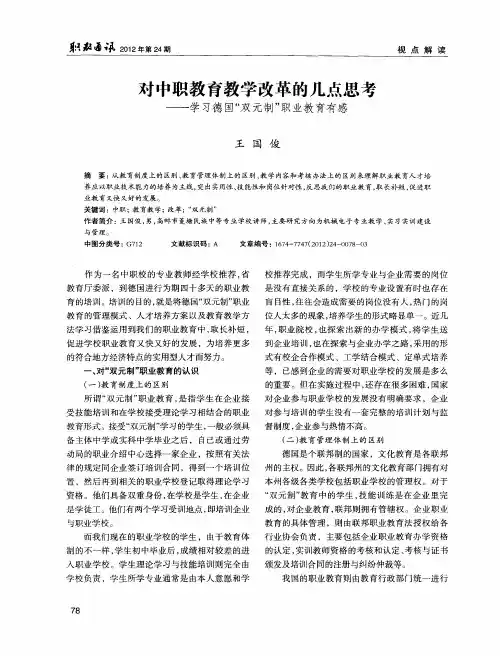
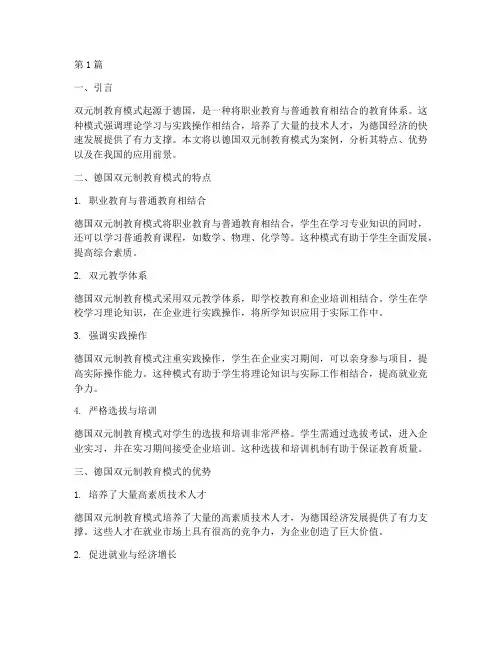
第1篇一、引言双元制教育模式起源于德国,是一种将职业教育与普通教育相结合的教育体系。
这种模式强调理论学习与实践操作相结合,培养了大量的技术人才,为德国经济的快速发展提供了有力支撑。
本文将以德国双元制教育模式为案例,分析其特点、优势以及在我国的应用前景。
二、德国双元制教育模式的特点1. 职业教育与普通教育相结合德国双元制教育模式将职业教育与普通教育相结合,学生在学习专业知识的同时,还可以学习普通教育课程,如数学、物理、化学等。
这种模式有助于学生全面发展,提高综合素质。
2. 双元教学体系德国双元制教育模式采用双元教学体系,即学校教育和企业培训相结合。
学生在学校学习理论知识,在企业进行实践操作,将所学知识应用于实际工作中。
3. 强调实践操作德国双元制教育模式注重实践操作,学生在企业实习期间,可以亲身参与项目,提高实际操作能力。
这种模式有助于学生将理论知识与实际工作相结合,提高就业竞争力。
4. 严格选拔与培训德国双元制教育模式对学生的选拔和培训非常严格。
学生需通过选拔考试,进入企业实习,并在实习期间接受企业培训。
这种选拔和培训机制有助于保证教育质量。
三、德国双元制教育模式的优势1. 培养了大量高素质技术人才德国双元制教育模式培养了大量的高素质技术人才,为德国经济发展提供了有力支撑。
这些人才在就业市场上具有很高的竞争力,为企业创造了巨大价值。
2. 促进就业与经济增长德国双元制教育模式有助于提高就业率,降低失业率。
学生在实习期间,与企业建立了良好的合作关系,毕业后更容易找到合适的工作。
此外,高素质的技术人才有助于提高企业竞争力,推动经济增长。
3. 增强国际竞争力德国双元制教育模式注重培养学生的实践能力和创新能力,使他们在国际竞争中具备更强的竞争力。
这种模式有助于提高德国在国际教育领域的地位。
四、德国双元制教育模式在我国的应用前景1. 提高职业教育质量德国双元制教育模式可以借鉴到我国职业教育中,提高职业教育质量。
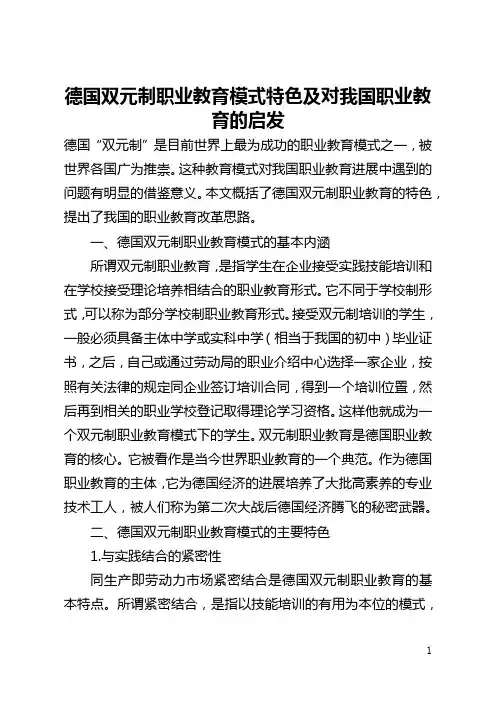
德国双元制职业教育模式特色及对我国职业教育的启发德国“双元制”是目前世界上最为成功的职业教育模式之一,被世界各国广为推崇。
这种教育模式对我国职业教育进展中遇到的问题有明显的借鉴意义。
本文概括了德国双元制职业教育的特色,提出了我国的职业教育改革思路。
一、德国双元制职业教育模式的基本内涵所谓双元制职业教育,是指学生在企业接受实践技能培训和在学校接受理论培养相结合的职业教育形式。
它不同于学校制形式,可以称为部分学校制职业教育形式。
接受双元制培训的学生,一般必须具备主体中学或实科中学(相当于我国的初中)毕业证书,之后,自己或通过劳动局的职业介绍中心选择一家企业,按照有关法律的规定同企业签订培训合同,得到一个培训位置,然后再到相关的职业学校登记取得理论学习资格。
这样他就成为一个双元制职业教育模式下的学生。
双元制职业教育是德国职业教育的核心。
它被看作是当今世界职业教育的一个典范。
作为德国职业教育的主体,它为德国经济的进展培养了大批高素养的专业技术工人,被人们称为第二次大战后德国经济腾飞的秘密武器。
二、德国双元制职业教育模式的主要特色1.与实践结合的紧密性同生产即劳动力市场紧密结合是德国双元制职业教育的基本特点。
所谓紧密结合,是指以技能培训的有用为本位的模式,突出技能和实践能力的培养,着力培养学生将来在社会上就业、适应、竞争和进展的能力;在工作中具体的发现、分析、解决和总结问题的能力及其操作、应用、维护和维修能力。
在这一思想的指导下,双元制职业教育形式下的学生大部分时间在企业进行实践操作技能培训,培训的过程中,接触的是企业目前使用的最新设备,掌握的是企业当下最新的技术。
在培训的基本程序上,以生产性劳动的方式进行,学生能较早地接近新技术、新工艺、新设备、新材料。
从而减少了费用并提高了学生学习的目的性。
这样的培训,能够使学生在培训结束后随即投入工作,成为企业的合格技术人员。
2.训练目标的关键性所谓训练目标的关键性是指训练中注重核心能力的培养。
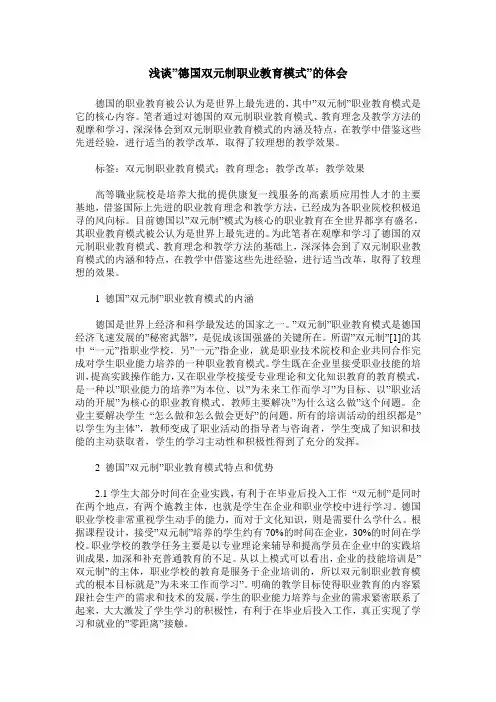
浅谈”德国双元制职业教育模式”的体会德国的职业教育被公认为是世界上最先进的,其中”双元制”职业教育模式是它的核心内容。
笔者通过对德国的双元制职业教育模式、教育理念及教学方法的观摩和学习,深深体会到双元制职业教育模式的内涵及特点,在教学中借鉴这些先进经验,进行适当的教学改革,取得了较理想的教学效果。
标签:双元制职业教育模式;教育理念;教学改革;教学效果高等職业院校是培养大批的提供康复一线服务的高素质应用性人才的主要基地,借鉴国际上先进的职业教育理念和教学方法,已经成为各职业院校积极追寻的风向标。
目前德国以”双元制”模式为核心的职业教育在全世界都享有盛名,其职业教育模式被公认为是世界上最先进的。
为此笔者在观摩和学习了德国的双元制职业教育模式、教育理念和教学方法的基础上,深深体会到了双元制职业教育模式的内涵和特点,在教学中借鉴这些先进经验,进行适当改革,取得了较理想的效果。
1 德国”双元制”职业教育模式的内涵德国是世界上经济和科学最发达的国家之一。
”双元制”职业教育模式是德国经济飞速发展的”秘密武器”,是促成该国强盛的关键所在。
所谓”双元制”[1]的其中“一元”指职业学校,另”一元”指企业,就是职业技术院校和企业共同合作完成对学生职业能力培养的一种职业教育模式。
学生既在企业里接受职业技能的培训,提高实践操作能力,又在职业学校接受专业理论和文化知识教育的教育模式,是一种以”职业能力的培养”为本位、以”为未来工作而学习”为目标、以”职业活动的开展”为核心的职业教育模式。
教师主要解决”为什么这么做”这个问题。
企业主要解决学生“怎么做和怎么做会更好”的问题。
所有的培训活动的组织都是”以学生为主体”,教师变成了职业活动的指导者与咨询者,学生变成了知识和技能的主动获取者,学生的学习主动性和积极性得到了充分的发挥。
2 德国”双元制”职业教育模式特点和优势2.1学生大部分时间在企业实践,有利于在毕业后投入工作“双元制”是同时在两个地点,有两个施教主体,也就是学生在企业和职业学校中进行学习。
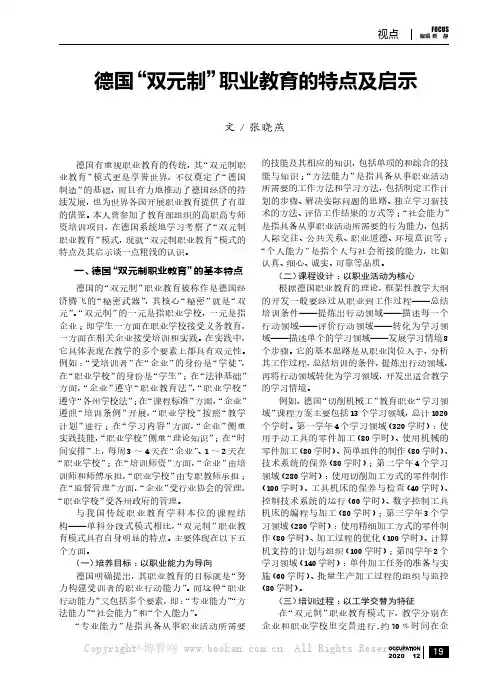
编辑 靳 静FOCUS视点编辑 靳 静德国有重视职业教育的传统,其“双元制职业教育”模式更是享誉世界,不仅奠定了“德国制造”的基础,而且有力地推动了德国经济的持续发展,也为世界各国开展职业教育提供了有益的借鉴。
本人曾参加了教育部组织的高职高专师资培训项目,在德国系统地学习考察了“双元制职业教育”模式,现就“双元制职业教育”模式的特点及其启示谈一点粗浅的认识。
一、德国“双元制职业教育”的基本特点德国的“双元制”职业教育被称作是德国经济腾飞的“秘密武器”,其核心“秘密”就是“双元”。
“双元制”的一元是指职业学校,一元是指企业;即学生一方面在职业学校接受义务教育,一方面在相关企业接受培训和实践。
在实践中,它具体表现在教学的多个要素上都具有双元性。
例如:“受培训者”在“企业”的身份是“学徒”,在“职业学校”的身份是“学生”;在“法律基础”方面,“企业”遵守“职业教育法”,“职业学校”遵守“各州学校法”;在“课程标准”方面,“企业”遵照“培训条例”开展,“职业学校”按照“教学计划”进行;在“学习内容”方面,“企业”侧重实践技能,“职业学校”侧重“理论知识”;在“时间安排”上,每周3~4天在“企业”、1~2天在“职业学校”;在“培训师资”方面,“企业”由培训师和师傅承担,“职业学校”由专职教师承担;在“监督管理”方面,“企业”受行业协会的管理,“职业学校”受各州政府的管理。
与我国传统职业教育学科本位的课程结构——单科分段式模式相比,“双元制”职业教育模式具有自身明显的特点。
主要体现在以下五个方面。
(一)培养目标:以职业能力为导向德国明确提出,其职业教育的目标就是“努力构建受训者的职业行动能力”。
而这种“职业行动能力”又包括多个要素,即:“专业能力”“方法能力”“社会能力”和“个人能力”。
“专业能力”是指具备从事职业活动所需要文 / 张晓燕德国“双元制”职业教育的特点及启示的技能及其相应的知识,包括单项的和综合的技能与知识;“方法能力”是指具备从事职业活动所需要的工作方法和学习方法,包括制定工作计划的步骤、解决实际问题的思路、独立学习新技术的方法、评估工作结果的方式等;“社会能力”是指具备从事职业活动所需要的行为能力,包括人际交往、公共关系、职业道德、环境意识等;“个人能力”是指个人与社会衔接的能力,比如认真、细心、诚实、可靠等品质。
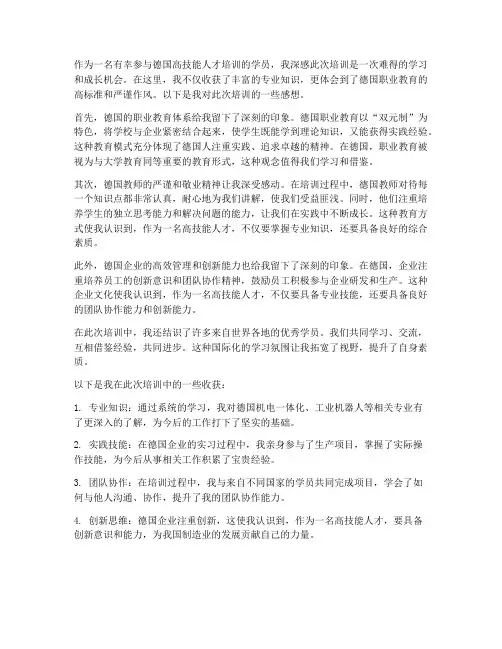
作为一名有幸参与德国高技能人才培训的学员,我深感此次培训是一次难得的学习和成长机会。
在这里,我不仅收获了丰富的专业知识,更体会到了德国职业教育的高标准和严谨作风。
以下是我对此次培训的一些感想。
首先,德国的职业教育体系给我留下了深刻的印象。
德国职业教育以“双元制”为特色,将学校与企业紧密结合起来,使学生既能学到理论知识,又能获得实践经验。
这种教育模式充分体现了德国人注重实践、追求卓越的精神。
在德国,职业教育被视为与大学教育同等重要的教育形式,这种观念值得我们学习和借鉴。
其次,德国教师的严谨和敬业精神让我深受感动。
在培训过程中,德国教师对待每一个知识点都非常认真,耐心地为我们讲解,使我们受益匪浅。
同时,他们注重培养学生的独立思考能力和解决问题的能力,让我们在实践中不断成长。
这种教育方式使我认识到,作为一名高技能人才,不仅要掌握专业知识,还要具备良好的综合素质。
此外,德国企业的高效管理和创新能力也给我留下了深刻的印象。
在德国,企业注重培养员工的创新意识和团队协作精神,鼓励员工积极参与企业研发和生产。
这种企业文化使我认识到,作为一名高技能人才,不仅要具备专业技能,还要具备良好的团队协作能力和创新能力。
在此次培训中,我还结识了许多来自世界各地的优秀学员。
我们共同学习、交流,互相借鉴经验,共同进步。
这种国际化的学习氛围让我拓宽了视野,提升了自身素质。
以下是我在此次培训中的一些收获:1. 专业知识:通过系统的学习,我对德国机电一体化、工业机器人等相关专业有了更深入的了解,为今后的工作打下了坚实的基础。
2. 实践技能:在德国企业的实习过程中,我亲身参与了生产项目,掌握了实际操作技能,为今后从事相关工作积累了宝贵经验。
3. 团队协作:在培训过程中,我与来自不同国家的学员共同完成项目,学会了如何与他人沟通、协作,提升了我的团队协作能力。
4. 创新思维:德国企业注重创新,这使我认识到,作为一名高技能人才,要具备创新意识和能力,为我国制造业的发展贡献自己的力量。
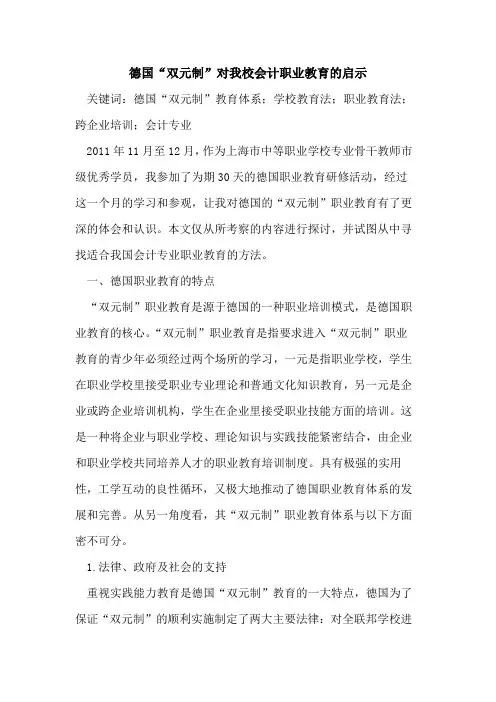
德国“双元制”对我校会计职业教育的启示关键词:德国“双元制”教育体系;学校教育法;职业教育法;跨企业培训;会计专业2011年11月至12月,作为上海市中等职业学校专业骨干教师市级优秀学员,我参加了为期30天的德国职业教育研修活动,经过这一个月的学习和参观,让我对德国的“双元制”职业教育有了更深的体会和认识。
本文仅从所考察的内容进行探讨,并试图从中寻找适合我国会计专业职业教育的方法。
一、德国职业教育的特点“双元制”职业教育是源于德国的一种职业培训模式,是德国职业教育的核心。
“双元制”职业教育是指要求进入“双元制”职业教育的青少年必须经过两个场所的学习,一元是指职业学校,学生在职业学校里接受职业专业理论和普通文化知识教育,另一元是企业或跨企业培训机构,学生在企业里接受职业技能方面的培训。
这是一种将企业与职业学校、理论知识与实践技能紧密结合,由企业和职业学校共同培养人才的职业教育培训制度。
具有极强的实用性,工学互动的良性循环,又极大地推动了德国职业教育体系的发展和完善。
从另一角度看,其“双元制”职业教育体系与以下方面密不可分。
1.法律、政府及社会的支持重视实践能力教育是德国“双元制”教育的一大特点,德国为了保证“双元制”的顺利实施制定了两大主要法律:对全联邦学校进行普遍约束的《学校教育法》和用于规范企业职业教育培训的《职业教育法》。
用法律、法规规范约束着具体的职业教育行为,明确学校和企业在职业教育中的职责。
在德国的“双元制”职业教育中,企业要和培训学员订立合同,具体由工商行会负责,合同一式四份,一份留存工商行会,一份交企业,一份交职业学校,一份留给培训生。
同时社会各阶层、舆论媒体对此经常监督,共同支持《学校教育法》和《职业教育法》的实施与监督。
2.企业的社会责任和培训意识德国规定,企业有培训员工的义务。
同时,德国是个充分市场经济的国家,企业主要以股份制、私有经济体为主。
因此,企业对人力资源的招聘和培训极为重视。
德国的“双元制”职业教育给我们的思考本文通过研究德国“双元制”职业教育情况,分析德国职业教育体系结构,结合我国的职业教育现状,提出了我国职业教育不能照搬德国的“双元制”,而是要围绕“与生产紧密的结合”和“校企的深度合作”来举办职业教育的观点。
标签:双元制;职业教育;校企合作一、德国的“双元制”职业教育概况德国职业教育的发展,在全球处于领先地位。
根据权威组织的统计,德国大学毕业生占同龄人的比例仅为20%,将近80%的年轻人接受的则是职业教育,并以此走上工作岗位。
正是通过成功的职业教育,为“德国制造”提供了大量优秀的产业工人,也成为德国国家竞争力的重要源泉。
在德国,职业教育的规模很庞大,很正规和也很全面。
确切地说德国人从小学毕业就可以开始选择自己的职业道路。
小学毕业以后他们可以选择一个向职业化方向发展的中学或者一个普通的。
而在中学的学习结束后,就可以选择上职业高中或者普通高中了。
在普通高中生毕业以后,学生们选择上标准的大学或者高等职业学校。
“双元制”有两个不同于许多国家职业培训常见的纯粹学校培训的特点:一是学生大部分的学习不在学校里,而是在生产场所或服务性企业中进行,或在一个企业里,或在一种自由职业的实践中,或在公共事业中。
受培训者有时候离开实践去上职业学校,所以同时也是职业学校学生。
这些人每周大约3-4天在企业里,大约1-2天在职业学校里接受培训。
二是培训由企業和职业学校两个培训承担者负责。
二者在德国分属不同的部门管辖,其中,联邦法律管辖企业中的培训,而学校领域里的培训是各州的事情。
企业中的培训在合乎技术要求的机器和设备前进行,较大的企业都有自己的徒工培训车间,较小企业中的受培训者直接在工作岗位上接受培训。
德国各州学校法规定受培训者必须上职业学校,职业学校的任务是在专业理论方面促进和充实企业中的培训(专业课程)和扩大受培训者的普通教育。
学校培训的内容三分之二是专业课,三分之一是普通教育课。
德国“双元制”职业教育制度有两个学习地点即企业和职业学校;有两种身份即学生与学徒,在企业,他们是学徒,而在职业学校,他们是学生;有两种考核即实践技能考试与专业知识考试。
德国培训个人总结长沙航空职业技术学院严勇今年9月12日到12月12日我有幸参加了湖南省教育厅组织的高职院校教师国外研修班,赴德国霍夫应用技术大学和莱比锡手工行会职业培训中心,进行了三个月的研修学习。
此次德国之行,不仅使我对德国的职业教育有了进一步的认识,而且对现代职业教育也有了更深刻的理解,对今后的教育教学也产生了很多启发和想法,总结如下。
一:对培训目的的思想认识现代职业教育是适应现代科学技术发展和生产方式变革,主要培养现代产业一线技术技能人才和促进全体劳动者可持续职业发展的教育类型。
改革开放以来,我国职业教育发展取得了巨大成就,中高等职业教育快速发展,职业院校基础设施日趋完善,教学能力显著提高,产教结合、校企合作不断深入,中高职衔接呈现良好势头。
但在充分肯定成绩的同时,必须清醒地看到职业技术教育发展中还存在着很多困难和问题。
我国职业教育仍然存在着发展理念相对落伍,职业教育层次结构不合理,人才培养模式相对陈旧,学生基础能力培养相对薄弱,基本制度不健全,国际化程度不高等诸多问题,并集中体现在当前的职业教育体系不适应加快转变经济发展方式的要求上。
从当前情况看,要办出受企业欢迎、社会认可、群众满意的职业技术教育,还有很大差距。
近年来,全球实体经济竞争的需求、我国产业转型升级的需求、新工业革命带来的生产方式变革的需求、终身教育发展的需求,正在汇集成推动现代职业教育发展的强大动力。
我们必须抓住当前的历史机遇,以战略眼光、先进理念和国际视野加快职业院校的发展和建设。
教师队伍建设是职业院校发展和建设的重要组成部分。
此次培训,湖南省教育厅从全省18个模具、数控和机械制造专业教学团队中遴选出7个团队的21名专业教师,在德国BSK国际教育机构的协助下,安排到了德国的应用技术大学、手工行会培训中心等地方研修。
应该说,组织一线专业教师到德国进行长达三个月的研修学习,针对性如此之强,在国内还是第一次。
因此我们对此次赴德研修机会倍感珍惜,在班委会和全体教师的共同努力、团结协作下,研修期间,参研教师精神状态好,学习秩序好,研修收获大,没有发生一起违反外事纪律、学习或生活纠纷的事件,为德方培训专家和有关企业员工和职业学校师生展示了新时代中国职业教师的良好风貌。
德国“双元制”职业教育对我国“双导师制”人才培养模式的启发和思考德国的“双元制”职业教育一直以来都备受国际瞩目,被认为是世界上最成功的职业教育体系之一。
而我国的“双导师制”人才培养模式也正是借鉴了德国“双元制”职业教育的经验和特点而提出的。
本文即将探讨德国“双元制”职业教育对我国“双导师制”人才培养模式的启发和思考。
我们需要了解一下德国的“双元制”职业教育究竟是什么。
简单来说,德国的“双元制”职业教育是指在工作和学习中相互结合的职业培训体系。
学生在校期间既要获得理论知识,又要接受实际工作实习,通过学校和企业双重教育体系的培养,最终达到既能解决实际问题,又拥有一定理论基础的目标。
这种培养模式实现了理论和实践的有机结合,确保了毕业生的就业质量和实际工作能力。
而我国将德国的“双元制”职业教育模式改良后应运而生的“双导师制”人才培养模式,同样也采用了学校和企业双重指导、双重培养的方式。
学生在校期间,不仅要参与课堂学习,还要到企业实习,由学校导师和企业导师共同负责培养学生的理论和实践能力。
德国“双元制”职业教育的成功经验可以为我国“双导师制”人才培养模式提供一些建议和启发。
我们可以借鉴德国的职业教育体系,在学校和企业之间建立更为紧密的合作关系,鼓励企业更多地参与学生的培养过程。
通过与企业的深度合作,学校能更加贴近实际工作需求,为学生提供更为实用的知识和技能。
学生在企业实习期间也能更好地了解实际工作环境,培养实际工作能力。
我们也可以在人才培养的内容和方法上借鉴德国的经验。
德国的职业教育不仅注重理论知识的传授,更注重学生的实际操作能力和问题解决能力的培养。
这一点对我国的“双导师制”人才培养模式也有着重要的启示意义。
我们应该着力培养学生的实际操作能力和解决问题的能力,让学生逐步成为具备创新精神和实践能力的复合型人才。
在培养体系和机制上,我们还可以借鉴德国的经验和做法。
德国的“双元制”职业教育有着完善的制度和规范,学校、企业和政府都各司其职,共同合作,确保了职业教育的质量和效果。
德国“双元制”职业教育的特色及其借鉴德国双元制职业教育德国是一个原料缺乏的工业国家,它依赖的是受过良好教育的技术力量。
在德国,不论担任那一种工作,完成那一种任务,“资格”是非常重要的,而这种“资格”,绝大多数是靠职业教育来实现的。
因此德国人把职业教育比喻为“经济腾飞的翅膀”、“经济发展的柱石”。
而德国职业教育中最具特色并成为其核心部分的是“双元制”职业教育模式。
“双元”是指学校――企业、理论――实践、思维――动手。
“双元制”职业教育的主要优点是:一方面既保持了传统的“师傅带徒弟式”技能方法的直接性、有效性,同时又克服了传统的学习技能方法的随意性强和理论知识的缺乏。
另一方面使学校和企业紧密结合,克服了学校闭门办学所造成的与企业要求脱节的情况,使学生一毕业就能直接上岗工作。
一、德国“双元制”职业教育的教学特色1.形成具有深厚的哲学底蕴的教学理念。
德国人重实务,也重思辩;既有强烈的国民性,又有浓厚的公民性。
黑格尔哲学中自由与必然的关系,为“双元制”中角色的演绎铺垫了深厚的哲学根基。
同时“双元制”在其历史进程中也充分体现着日耳曼民族重视技能的文化传统,其中,既有瑞士教育家裴斯泰洛齐“3H”(手、脑、心)思想和斯普朗格“陶冶”理念的渗透,又有凯兴斯泰纳劳作教育论和公民教育思想的灌注,以及洪堡以重视个性、培养多能而造就优秀人才振兴民族国家的民主教育思想的熏陶。
因此,德国教育专家胡勃先生认为:“德国的职业教育体系与其称它为一种教育制度,不如称它为一种‘思想’,是一种注重实践、技能为未来工作而学习的思想”。
在德国,全社会有一种共识:教育是对未来的投资。
没有经过职业教育的人不能进入工作岗位。
德国职业教育的目标有两个:一是为年轻人开设一条成功的职业道路;二是保证年轻人掌握一种胜任经济发展和工作需要的技能。
有人说,“哲学”是一门“追求智慧的学问”。
当大多数人只注意花和果、枝和叶的时候,不要忘了,一棵树长成什么样子,是它的树根和树干决定的。
国际“双元制”职业教育专题培训总结2020年这个特殊的暑期,我非常有幸参加了教育部教师工作司和同济大学联合主办的国际“双元制”职业教育专题线上培训班,受益匪浅,总结如下:一、此次培训班的收获1.站在更高的视角了解当前职业教育的发展趋势从去年年初的职教二十条到高职百万扩招,这期间国家出台了一系列政策文件,在给高职教育带来重大发展机遇的同时,也预示着职业教育未来发展的挑战。
尤其是鲁昕部长在开班典礼上的报告《新经济新技术新融合新双元》,提出了中国职业教育不同于德国的行业指导下的双元校企合作,而是政府引领下包括政府、行业、企业、学校、教师、学生的多元合作,由政府搭建平台,培养职业院校师资。
重点介绍了数字经济下的产教融合的中国政策、中国实践、中国理念和中国趋势,高屋建瓴地对国家级创新团队提出了新要求。
2.系统学习了德国双元制的人才培养模式德国双元制人才培养模式以前在不同的场合零散学习过一些,把“双元制”理解为职业学校和企业两个教育主体合作进行职业教育的一种模式,但是在具体实践上,我们目前所做的校企合作与德国双元制相比较究竟还有哪些不足,为什么我们的职业教育课程资源开发和实施如何很好的施行校企双元,如何从使职业教育提供的教育服务能够更好地满足企业的需求等这些问题一直没有找到答案。
在本次培训中同济大学的研究团队给我们从德国双元制人才培养模式的制度框架和发展趋势、课程体系设置和具体实施、课程资源开发、成果评价和资格考试等几个方面进行了系统讲解,无论从方法论还是具体实践都做了行之有效的讲解和示范。
同济大学王继平书记从职业教育质量保障体系开始讲起,分析了德国职业教育质量保障的核心经验,专家团队从德国经济发展变化的大背景介绍了德国双元制高等教育的产生和发展,对德国职业教育的本土化情况提出了自己的见解。
特别是师慧丽和陈永芳两位教授从学习任务开发、面向学习任务的教学资源开发以及学习任务实施等方面为我们做了具体的指导,使我从理论到实践上对德国双元制人才培养模式有了系统的认知。
德国双元制职业教育的优势、走向及启示摘要:双元制是德国独具特色且卓有成效的职业教育制度。
本文介绍了德国双元制职业教育的内涵、优势,分析了当前德国双元制职业教育的走向,最后探讨了双元制对我国职业教育所具有的启示。
关键词:德国;双元制;职业教育一、德国双元制职业教育的涵义德国双元制是一种青少年在企业里接受职业技能培训,部分时间在职业学校里接受专业理论和普通文化知识的职业学校义务教育形式。
它将企业与学校,理论知识和实践技能紧密结合起来,是一种主要以专业技术的工人为培养目标的职业教育制度。
“双元制”中的“双元” 就是指两个地点的学习:“一元”为职业学校,另“一元”为企业培训。
这两个地点的内容和形式相对独立,构成了双元制职业教育模式。
企业培训由联邦政府主管部门负责,执行其颁布的培训条例。
职业学校教育的组织管理则由各州负责。
在培训时间的分配上,企业每周3~4天,职业学校每周1~2天;在教育经费分担上,企业培训的费用大部分由企业承担,职业学校费用由国家及州政府承担。
二、德国双元制职业教育的突出特点及优势1教育与生产紧密结合。
双元制强调的是就业和直接通向生产岗位为未来而工作的一种教育,而不是其他什么“基础教育”和“晋升教育”。
以培养生产第一线实际操作人员的双元制职业教育真正成为受企业欢迎的教育。
双元制职业教育形式下的学生大部分时间在企业进行实践操作技能培训,而且所接受的是企业目前使用的设备和技术,培训在很大程序上是以生产性劳动的方式进行,从而减少了费用并提高了学习的目的性,这样有利于学生在培训结束后随即投入工作。
同时,联邦政府还发动社会力量(包括同业公会、行业协会、地方政府和相关部门)共同关心和支持办好职业教育,形成一股合力,共同承担义务,推动职业教育的健康、快速发展。
2企业广泛参与培训。
企业的积极参与是双元制顺利实行的前提。
大企业多数拥有自己的培训基地和人员。
没有能力单独按照培训章程提供全面和多样化的职业培训的中小企业,也能通过跨企业的培训和学校工厂的补充训练或者委托其他企业代为培训等方法参与职业教育。
一、公务员设置范围国外公务员设置范围的大小 ,取决于对公务员的定位
页脚内容
6
中德职业教育合作师资培训
德国双元制标准化师资培训
总结
2017年7月5日至7月14日,我参加了中德职业教育合作德国
双元制标准化师资培训的学习。通过这十天的学习,使我对德国的职
业教育有了更新的认识。通过这次的学习,开拓了我的视野,丰富了
我的专业知识,增加了见识,更新了教育理念,加深了对职业教育的
理解,坚定了我作为一名职业教师的信心和决心。参加培训总的感觉
是,走出去,可以知道自己能力与水平,也可以知道别人的长与短,
有助于完善自己,丰富自己,提高自己,具体说:接触到了最新的职
业教育理念,刷新了自己对职业教育的认知。
本次培训由德国职业教育专家Uwe.Heiber博士主讲。主要内容
是德国的双元制职业教育模式,包含了德国的职业培训模式概述;教
学法和教学论以及课程开发的基本知识。其中在教学法中,博士不仅
对传统教学法进行了阐述,还重点讲解了行为导向教学法中的实验法、
角色扮演法、思维导图法、鱼骨图法及项目教学法等。为了培训需要
和加深学员的印象,培训期间我们还实地参观考察了立中集团。博士
讲课,严谨中不失幽默,给我们留下了深刻的音像。
德国双元制职业教育举世瞩目并始终处于世界领先地位,而德国
经济腾飞的秘密武器便是德国双元制职业教育。所谓“双元制职业教
一、公务员设置范围国外公务员设置范围的大小 ,取决于对公务员的定位
页脚内容
6
育”就是整个培训过程是在工厂企业和国家的职业学校
(Berufsbildenden Schule 简称 BBS)进行,并且这种教育模式又
以企业培训为主,企业中的实践和在职业学校中的理论教学密切结合。
德国双元制模式学制为2~3.5 年, 一般主体为中学毕业生, 其
智力特征以形象思维为主, 培养目标为技术管理人员。教学分别在企
业和职业学校里交替进行, 约60%-70%时间在企业, 40%-30%时间在
学校。在培训的组织方式上,采用由企业进行实际操作方面的培训,
培训学校完成相应的理论知识的培训,企业与职业学校两方面共同完
成对职业学校学生的培训工作。
德国双元制模式的课程设计以职业需求为核心。德国双元制模式
的理论课程设计是以职业活动为中心选择课程内容的,理论课覆盖了
专业所需的所有理论, 知识面广, 深浅适度, 综合性强, 有利于培
养学生的综合分析问题和解决问题的能力。而所有的课程都按照学期
进行细分,无论哪一学期的课程,始终都是围绕汽车维修实践从泛到
精、由浅入深展开的。课程的选择都是经由教学经验丰富的业内专家
综合编排的,更注重直接性的职业经验。
德国双元制模式的本质在于,向年轻人提供职业培训,使其掌握
职业能力,而不是简单地提供岗位培训。德国双元制模式不仅注重基
本从业能力、社会能力而且特别强调综合职业能力的培养,更 加注
重的是综合职业能力。
德国双元制模式所培养出的综合职业能力是一种跨职业的能力,
对我们未来的发展起着关键作用。通过德国双元制模式培训的学生,
一、公务员设置范围国外公务员设置范围的大小 ,取决于对公务员的定位
页脚内容
6
可以胜任其职业领域里的所有工作任务,而不仅仅局限于某一工作岗
位的任务。他们在掌握了业务能力的基础上,还学会大量基础知识以
及有实用价值的社会能力,其适应能力就得到了大大的增强,为人生
道路作了坚实铺垫。
德国双元制模式不但具有较强的技术鲜明性,超前性,而且更注
重培养学生的职业道德。通过培训使学生获得宽广的知识技能面, 具
备较强的社会适应性和市场竞争力。
德国双元制模式的主要特点:
(1)同生产紧密结合,培训目标更符合企业的需要。德国双元
制模式下的学生大部分时间在企业进行实践操作技能培训,而且所接
受的是企业目前使用的设备和技术,培训在很大程序上是以生产性劳
动的方式进行,从而减少了费用并提高了学习的目的性,学生的学习
目的明确“为未来工作而学习”大大激发了学生的学习动机;这样有
利于学生在培训结束后随即投入工作。
(2)企业的广泛参与。大企业多数拥有自己的培训基地和人员。
没有能力单独按照培训章程提供全面和多样化的职业培训的中小企
业,也能通过跨企业的培训和学校工厂的补充训练或者委托其他企业
代为培训等方法参与职业教育。
(3)真实的生产环境及先时的设施设备,使学生比较接近实践,
接近未来工作的需要;
(4)能较早地接近新技术、新工艺、新设备、新材料。
这带给我们的启发是:(1)相对于学校制职业教育,双元制职业
一、公务员设置范围国外公务员设置范围的大小 ,取决于对公务员的定位
页脚内容
6
教育更注重实践技能的培养并使之确切保证。这使得以培养生产第一
线实际操作人员的职业教育真正成为受企业欢迎的教育。虽然我国目
前了非常重视学生实际操作技能的培养,但学校制的培养模式客观上
使学生远离了生产第一线,而集中安排的生产实习又不利于学生及时
将所学理论同实践相结合。
(2)在双元制职业教育体制下,由于学生在特定的工作环境中
学习,使得学生和企业有了更多的交流机会,大大降低了培训后失业
的风险。这对我国多年难以解决的对口录用问题有一定的借鉴意义。
(3)同我国现行的偏重系统理论传授的职业教育教学内容相比,
以岗位要求为培训目标的双元制职业教育更受企业的欢迎。以工人技
术等级考核标准的要求为培养目标并构建与之相适应的教学大纲和
教学内容体系,应当是我国职业教育教学改革的重要内容。
(4)由于跨企业培训中心具有其它形式无可比拟的优势,在前
东德地区被越来越多地用来作为培训机构不足的补救措施。对于我国
而言,众多的中小企业难以单独举办职业教育中心,因此,组织企业
联合举办或者由行业主办跨企业培训中心将是一个非常重要的发展
职业教育的途径。
中国教育部从80年代初开始在这一领域和德国有关机构进行合
作(如汉斯塞德尔基金会,德国技术合作公司),实施“双元制职业
教育”试点工作。中德两国总理于1993年签署了职业教育合作的联
合倡议书,足以说明两国政府对这项合作的重视。这次培训,颇有相
见恨晚的感觉。
一、公务员设置范围国外公务员设置范围的大小 ,取决于对公务员的定位
页脚内容
6
行动导向教学是以“行动导向驱动”为主要形式,在教学过程中
充分发挥学生的主体作用和教师的主导作用,注重对学生分析问题,
解决问题能力的培养,从完成某一方面的“任务”着手,通过引导学
生完成“任务”,从而实现教学目标。从学生接受知识的过程看,知
识来源于实践,在实践中得到感性认识,经过反复实践才能上升到理
性认识,并回到实践中去。行动导向教学要求教师在教学中要把大任
务分解成小任务。教师要分层次地给学生下达行动导向。
其基本的教学步骤为:
1、课前准备:教师于课前做好充分的准备,如:多媒体课件的
准备,教学任务书的准备,学生组内分工的设计,教学设备的准备,
学生完成任务所必需的材料、元器件准备,仪器仪表的准备等。
2、下达任务:教师以简洁的语言陈述这节课的任务,并下发任
务书,任务书包括:主题、时间、注意事项等。
3、完成任务:这个阶段是行动导向教学法的主体部分。教师引
导学生掌握完成任务的基本思路、方法后,按学生的具体学情,化分
学习小组,组内分工协作,完成作“任务”,形成“作品”。
4、展示学生作品,教师引导学生对作品进行讨论,找出规律特
点,并对学生作品作出积极的评价。
其意义在于:
1、“行动导向”教学,让学生即学即用,激发和培养学生的学习
兴趣。采用“行动导向”教学,可以变抽象为具体,变枯燥为有趣,
让学生乐于去操作、掌握。当学生完成了某一任务后,内心就会产生
一、公务员设置范围国外公务员设置范围的大小 ,取决于对公务员的定位
页脚内容
6
一种成就感,一种喜悦感,一种冲击力,这种力量不仅增强了学生的
自信心,还提高了学生学习知识和技能的兴趣。
2、“任务”贯穿始终,让学生在讨论任务、分析任务、操作完成
任务的过程中顺利建构起知识结构。
3、因材施教,突出培养学生的实践能力和创新能力。
当然,Heiber博士也提到:教学中,“法无定法”,老师乐于教、
学生乐于学,适合的方法就是好方法,不论是传统教学法还是行动导
向教学法。同时,博士多次提到学生管理对教学的影响,他特别指出,
教学中,对于那些极个别的不学习、不服从管理的学生必须要有政策
性的约束。
德国的职业教育,从“学徒制”到“双元制”历经约百年时间,
我国从80年代初引进并试点实行,到现在已经取得了巨大的成效,
但职业教育改革压力依然巨大,任务依然艰巨。每个职业教育人都要
爱岗敬业,在自己的岗位上充分发挥自己的作用,不怕苦、不怕累,
虽筚路蓝缕,但众志成城。
最后,再次感谢Heiber博士的精彩讲解,感谢学院领导给予的
这次培训机会;感谢各级领导对这次培训的大力保障;感谢一起勇战
酷暑、刻苦学习老师们,谢谢!本次培训,受益匪浅。
2017年7月16日